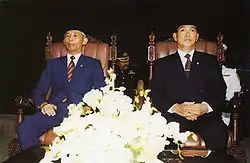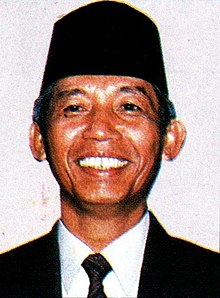Sudharmono
Sudharmono (EVO: Soedharmono; 12 March 1927 – 25 January 2006) was an Indonesian politician and military officer. He served as its fifth vice president between March 1988 and March 1993.
Sudharmono | |
|---|---|
 | |
| 5th Vice President of Indonesia | |
| In office 11 March 1988 – 11 March 1993 | |
| President | Suharto |
| Preceded by | Umar Wirahadikusumah |
| Succeeded by | Try Sutrisno |
| Chairman of Golkar | |
| In office 1983–1988 | |
| President | Suharto |
| Preceded by | Amir Murtono |
| Succeeded by | Wahono |
| Personal details | |
| Born | 12 March 1927 Gresik, Dutch East Indies |
| Died | 25 January 2006 (aged 78) Jakarta, Indonesia |
| Resting place | Kalibata Heroes Cemetery, Jakarta |
| Political party | Golongan Karya |
| Spouse(s) | Emma Norma (m. 1951) |
| Children | 5 |
| Profession | Military officer, Politician |
| Military service | |
| Allegiance | |
| Branch/service | |
| Years of service | 1945–1968 |
| Rank | |
| Commands | Ronggolawe Division Supreme Operations Command |
| Battles/wars | Indonesian National Revolution Indonesia–Malaysia confrontation |
Early life
Sudharmono was born on 12 March 1927 in Gresik, now of East Java. He lost both his parents in the space of six months when he was only three. Sudharmono then went to live with his uncle, a scribe serving in the Regency of Jombang, East Java. As he grew up however, he would move around a lot, living with family from both his father's and his mother's side.
Sudharmono had just completed Junior High School when Indonesia proclaimed its independence from the Netherlands in 1945. After deciding to drop out from any further education, Sudharmono assisted in collecting weapons from the Japanese troops in preparation of the formation of an Indonesian Army. As a result of this, he became the Commander of the Ronggolawe Division, a position which he held throughout the course of the Indonesian War of Independence against the returning Dutch troops.
Career
After the Dutch retreated in 1949, Sudharmono completed his Secondary Education before going to Jakarta in 1952 to join the Military Law Academy. He completed the course in 1956 before serving in Medan, North Sumatra as an Army Attorney from 1957–1961. In 1962, Sudharmono received his degree in law after completing a course at Military Law University. After this, Sudharmono was appointed Chairman of the Central Government Personnel Orders Unit and provided administrative assistance to the Government.
During the Indonesia-Malaysia confrontation, President Sukarno formed the Supreme Operations Command (KOTI), which was a war command immediately under Sukarno's control. In 1963, Sudharmono joined KOTI and was given the role of Joint Centre Operations Member for the Supreme Operations
The New Order
It was from this position that Sudharmono began his rise. In October 1965, Major General Suharto was appointed Army Commander and joined KOTI as its Chief of Staff. Suharto formed a relationship with Sudharmono during these tense times in Indonesian history and it was evident that Sudharmono earned Suharto's trust. On 11 March 1966, when Suharto received the Emergency Powers from Sukarno, Sudharmono was the one who reproduced copies of the letter to be distributed to other Military Officers. The next day, on 12 March 1966, Sudharmono was also the one to write the decree banning PKI.[1]
With Suharto's rise to power, KOTI was disbanded but Sudharmono's administrative skills and the trust that he had earned from Suharto ensured him a position in Suharto's administration. When Suharto became President in 1968, Sudharmono was named Cabinet Secretary as well as Chairman of the Economic Stability Council. In 1970, Sudharmono was moved from the position of Cabinet Secretary to the State Secretary, a position which allowed him to assist Suharto in the day-to-day running of the Government. Whilst State Secretary, Sudharmono also covered for other Ministers when they are unable to perform their duties; with short stints as Interim Information Minister and Interim Home Affairs Minister as well as helping to produce Suharto's accountability speech before the People Consultative Assembly (MPR) General Session.
In 1980, Sudharmono's position as State Secretary received a significant boost through a Presidential Decision which gave the State Secretary the power to supervise Government purchases exceeding 500 Million Rupiahs.
Chairman of Golkar
By the 1980s, Sudharmono had proved his loyalty to Suharto and had also shown that he does not have any ambitions. At the 1983 Golkar Congress, with Suharto's support, Sudharmono was elected as the Chairman of Golkar.
As Chairman, Sudharmono conducted many inspection tours of Golkar branches in the regions. Sudharmono also initiated a membership drive to get more voters to Golkar, an initiative that paid dividends in the 1987 Legislative Elections when Golkar's votes increased from 64% to 73%. The 1987 Legislative Elections was also a historical one for Golkar as it emerged victorious in the Province of Aceh for the first time.[2]
Vice Presidency
Nomination controversy
As the MPR convened for its 1988 General Session, it was widely believed by many that Suharto (who was 67 years old) would be elected to his fifth and last term as President. With that in mind, the Vice Presidency became a crucial position. As 1988 began, Suharto began to show signs that he wanted Sudharmono to become his Vice President. Although never mentioning Sudharmono by name, Suharto said that he wanted his vice president to enjoy the support of a large socio-political force.[3]
The possibility of Sudharmono becoming Vice President displeased many in ABRI. Although Sudharmono had been an Army man himself and had ended his career with the rank of Lieutenant General, he had spent most of his career behind a desk instead of commanding troops. For this, he was looked down upon by ABRI. Suharto was aware of this and before ABRI could do anything, replaced Benny Moerdani with Try Sutrisno as ABRI Commander. This move crippled ABRI as Moerdani was more assertive when it comes to disagreeing with Suharto while Try, having been Suharto's aide-de-camp would be more passive.
When the nomination was finally taken up through the official channels with Golkar, the Bureaucrats and Functional factions unanimously agreed to nominate Sudharmono as Vice President. The ABRI faction's nomination was delayed, with Moerdani continuing to procrastinate by claiming that he had not discussed the Vice Presidential nomination yet.[4] It was said that he wanted Try to become the Vice President.
At the 1988 MPR General Session in March 1988, controversy continued to dog Sudharmono's nomination as Vice President. First, Brigadier General Ibrahim Saleh interrupted the Session and was beginning to launch a scathing attack to Sudharmono before he was taken down from the podium by ABRI MPR members. Then Sarwo Edhie Wibowo, a General who had helped Suharto get to power in the mid-60's resigned from both his MPR and People's Representative Council (DPR) seat in protest. Finally, United Development Party Chairman, Jailani Naro nominated himself as Vice President, presumably with the private backing in ABRI, who in public supported Sudharmono's nomination.
Suharto finally intervened. He cited a decision that the MPR made in 1973 that one of the criteria for a Vice President was that he should be able to work with the President. Suharto also conducted discussions with Naro and convinced him to withdraw the nomination. With Naro out of the way, Sudharmono was finally elected as Vice President.
Term as Vice President

As Vice President, Sudharmono was extremely active. He regularly visited the Provinces and set up Mailbox 5000, a place where the people can send their suggestions and complains and the government. Sudharmono, ever the specialist in giving administrative assistance, was also given the duty by Suharto to supervise government bureaucracy.
Despite this however, ABRI continued to show their displeasure at Sudharmono's election as Vice President. At the Golkar Congress in October 1988, ABRI got their revenge against Sudharmono when they secured the election of Wahono as the Chairman of Golkar. ABRI members were also responsible for a smear campaign which involved accusing Sudharmono as a communist. Finally in March 1993, to prevent having to deal with a Vice President that they did not like, ABRI nominated Try Sutrisno as Vice President without waiting for Suharto to make his choice.
Possible President?

In his book, Suharto: A Political Biography, Robert Elson theorized of the possibility of Sudharmono's Vice Presidency being the final step before the Indonesian Presidency itself[5] and that Suharto only continued because of the reaction to Sudharmono's nomination There are two reasons for this:
- 1: As State Secretary, Sudharmono's duty was to assist the President in the day-to-day administration of the Government. Having held this position for 15 years prior to being elected Vice President, Sudharmono was sure to have been familiar with the inner workings of the Suharto regime.
- 2: ABRI would not have gone to extreme lengths to show their displeasure at Sudharmono being elected Vice President if they did not expect a long-term effect.
Post-VP
In 1997, Sudharmono released his autobiography, Pengalaman Dalam Masa Pengabdian (Experiences During Time of Service). Concurrently, a book was also released called Kesan dan Kenangan dari Teman: 70 Tahun H. Sudharmono SH (Impressions and Memories from Colleagues: 70 Years of Sudharmono) which talked about Sudharmono from the point of view of those who he had worked with. Because the release of these books happened a year before the 1998 MPR General Session, there were rumors that Sudharmono was going to make a political comeback and aim for the Vice Presidency once again.[4]
In May 1998, on the eve of Suharto's fall, Sudharmono, together with former vice presidents Umar Wirahadikusumah and Try Sutrisno visited Suharto at his residence to discuss possible options.
Sudharmono also continued to manage Suharto's Foundations (Yayasan).
Death
Sudharmono died on 25 January 2006. His body was buried in the TMP Kalibata, Jakarta.
Family
Sudharmono married Erma Norma, with whom he had five children. His last son has three children.
Portrait
 Another Portrait Sudharmono as Vice President
Another Portrait Sudharmono as Vice President Portrait as Secretary of Cabinet
Portrait as Secretary of Cabinet Portrait in full military uniform
Portrait in full military uniform
See also
- List of Vice Presidents of Indonesia
Notes
- Elson, Robert (2001). Suharto: A Political Biography. UK: The Press Syndicate of the University of Cambridge. p. 138. ISBN 0-521-77326-1.
- "70 Tahun Sudharmono SH (2-Habis)". Suara Merdeka. 15 March 1997. Archived from the original on 18 September 2006. Retrieved 28 October 2006.
- Vatikiotis, Michael R.J. (1993). Indonesian Politics Under Suharto. New York: Routledge. p. 83. ISBN 0-415-08280-3.
- MIS (22 March 1997). "Sudharmono "Mengudara" Kembali". Tempo. Archived from the original on 27 September 2007. Retrieved 28 October 2006.
- Elson, Robert (2001). Suharto: A Political Biography. UK: The Press Syndicate of the University of Cambridge. pp. 258–260. ISBN 0-521-77326-1.
References
Elson, Robert (2001). Suharto: A Political Biography. UK: The Press Syndicate of the University of Cambridge. ISBN 0-521-77326-1.
External links
- (in Indonesian) Bio at Ensiklopedi Tokoh Indonesia
- (in Indonesian) Article on ABRI's reluctance to nominate Sudharmono as Vice President
- (in Indonesian) profile on Tokoh-indonesia.com
| Political offices | ||
|---|---|---|
| Preceded by Alamsyah Ratu Perwiranegara |
State Secretary of Indonesia 1972–1988 |
Succeeded by Moerdiono |
| Preceded by Umar Wirahadikusumah |
Vice President of Indonesia 1988–1993 |
Succeeded by Try Sutrisno |
